
DIE RAD-WETTFAHRT
Oehmigke und Riemschneider, Germany, 1890s

This is an old game of which there are a few different versions. The game was also released in the Netherlands as "De Fietswedstrijd" (scroll down to see a couple of Dutch examples). However, German versions appear to be more usual, and at least one of them is clearly older than any known Dutch version, so I think the game is originally German. I cannot be 100% sure, though. Any further information is welcome.
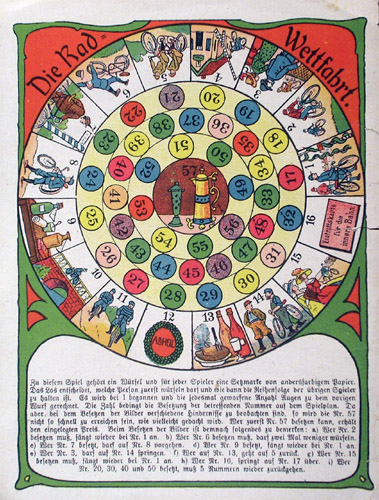
One of the versions of the game is quite well-known. It is a large (41 x 33 cm) print that was (possibly) included in a multigame book. I have at least another game belonging to the same collection. game. The cycling game is number 9558 (while the other game, "Neues Glücks-Spìel", is nr. 8017). Both have a black and white mill board (aka Nine Men Morris) board printed on the back. These books containing game boards (generally between 4 and 8) were not unusual at the turn of the century.

This game is reproduced in Parabel's 1985 book Wer wagt gewinnt: Alte Würfelspiele". The game is displayed on a double page, roughly in the original size, but unfortunately no further description is offered. There are three other games in the book: Gänsespiel, Affenspiel, and Neuestes Post- und Reisespiel.

The second version of the game is a strangely small print (20 x 15 cm), too small to be really playable. At first sight both boards look quite similar but, on closer examination, we see that the game was completely redrawn at some point. There is even a mistake in the rules, concerning the "All Heil" square No. 12. The big version translates into "Whoever comes to Nr. 12 may jump to Nr. 14". The small version says "Whoever Nr. 3 may jump to Nr. 14". (Thanks, Siegfried, for spotting this one!)
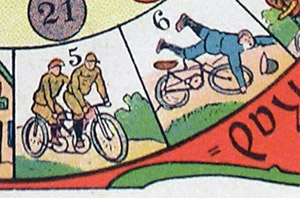
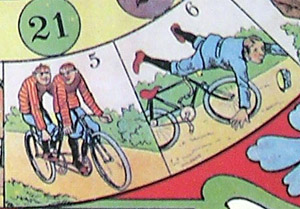
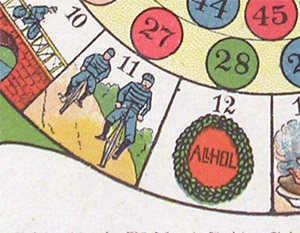
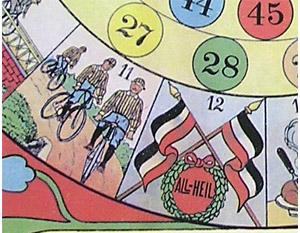
Small print on the left, bigger version on the right
There is an important detail: The flags on the bigger version of the game are the imperial German flags used until 1918. So this board is pre-WWI, while the smaller print is probably a later edition made after the war, when the Weimar Republic had changed the flag to the one we have now. UPDATE 2025: Based on new information and comments sent by Siegfried L., I am now dating this game as being made in the second part of the 1890s, a little earlier than I used to believe. Expect some detailed rewriting as soon as I find time to do it properly.
By the way, in case you wonder about the meaning of "All-Heil", it is (or used to be) the usual German greeting between cyclists. In the early years of German cycling sports "All Heil" also had been used to greet the finishers of a race, instead of having an ordinary banner simply saying "Ziel" ("finish"). See, for instance, a drawing on the cycling4fans.de site depicting the 1894 Mailand-München (Milan-Munich) race, in which we see such a banner.
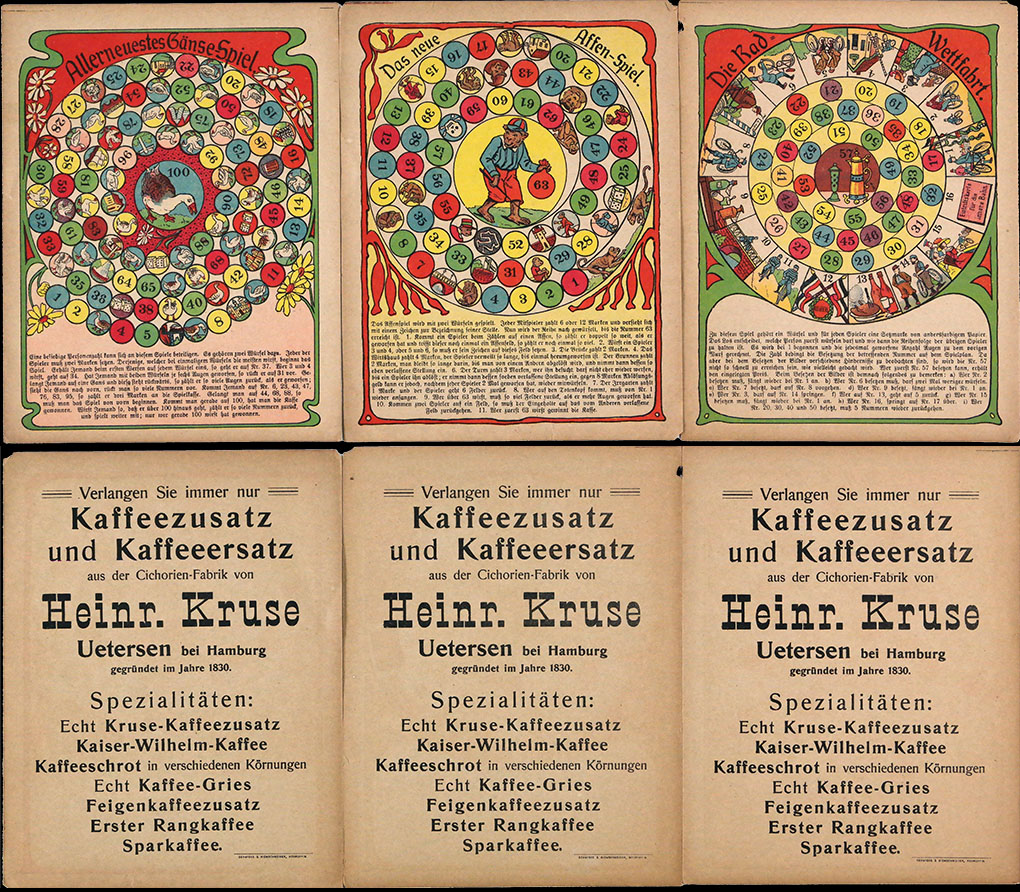
Adrian Seville has a group of three small-format games, all being miniature versions of full-size games printed with advertisements for Heinr. Kruse coffee shop (from Uetersen, near Hamburg) on the back. They measure 20 x 15 cm, and one of them is Die Rad-Wettfahrt. It is identical to my small copy of the game, except that my back is not printed. Adrian suggests these small sheets were given free to children at the shop. That would explain the mystery of the rather unplayable small version of the game. Though we do not know of other examples, we expect that these small sheets were back-printed to order for other advertisers.
Daniela Merela, a German collector of cycling-related items, has more versions of this game. Among them is Die Velociped-Wettfahrt, the oldest known version of this game, probably from the 1880s. Even the word "Velociped" is from the 1880s (according to Daniela's sources, the word fell out of use soon). Notice the Imperial German flags on field 12. This game is printed on a 41x34 cm paper sheet, much like my "big" version of the game. Notice also that this game already had the number 9558.
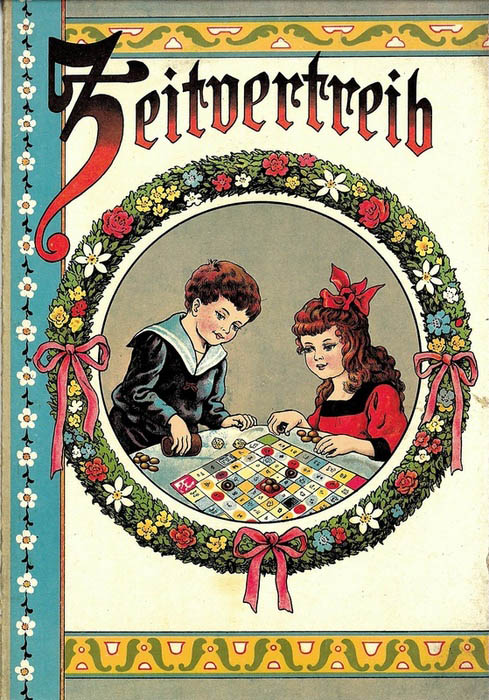
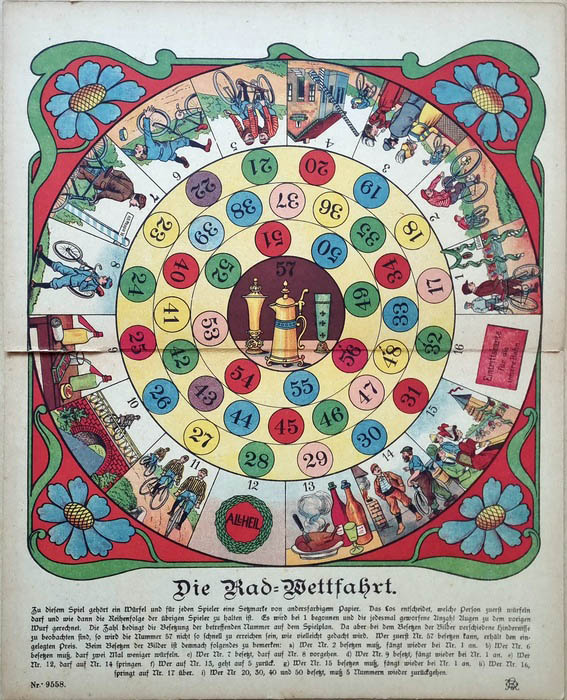
Another version in Daniela's collection is the one included in this Zeitvertreib book along with three other games (Neues Gänsespiel, Allerneustes Jägerspiel, Das neue Affen-Spiel). As you can see, the games are printed on two pages of the book. Since the book measures 32.8x20.4 cm, the unfolded games are roughly the same size as the "big" prints. This game is very similar to my "big" version, including the number 9558, except for the lack of flags on field 12, which, as I argued above, suggests that this edition was made after WWI. (No doubt Parabel's 1985 book was inspired by this one, though the game selection is slightly different).

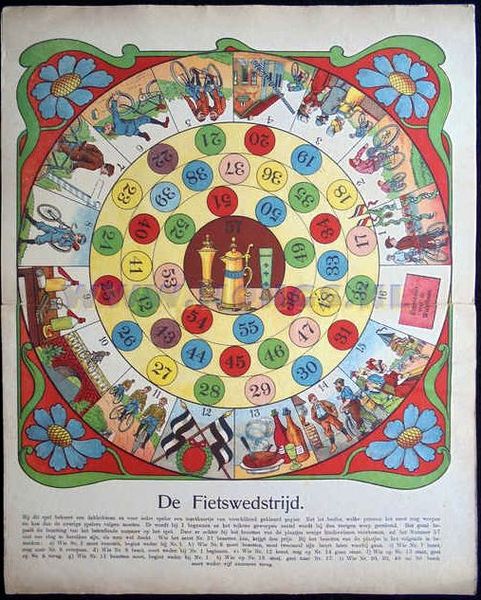
The now-defunct (*) HONGS website displayed at least two versions of "De Fietswedstrijd", the Dutch version of the game, which they dated from around 1905-1910. Both were part of multigame books. Although, unfortunately, the sizes of the games were not specified, they are very similar to the bigger German game, as you can see. The most important difference is square 12, which has a different flag (one different in each game), and of which the legend "All-Heil" has been removed. The one on the left board is the flag used by the German territory of Würtemberg before 1945, the other is from West Prussia. Why would the Dutch versions of the game use German flags instead of replacing them with their own tricolour flag? My guess is that it was for financial reasons, which would prove -if further proof was needed- the German origin of the game. But then there should exist German versions of the games with these same flags. Maybe this Rad-Wettfahrt game has still more surprises to offer!
(*) The HONGS website can be accessed through the Internet Archive, though the internal search engine does not work anymore and the games cannot be retrieved. At least I have not been able to. Fortunately, I saved the game information before the HONGS archive disappeared. For the record, in case this situation should change, the index numbers of these games on the HONGS files were 19025 and 12210.
This shows you that you cannot take for granted that digital information will still be there the day you need it. This is also one of the reasons this website is in plain static HTML: it is much easier to save and will be readable much longer. I have just accessed a 2004 version of this site (when the domain name was still cyclingboardgames.tk), and it works quite well; all games can be accessed, though most pictures can't: only a few thumbnails and scattered small-sized pictures are there, but you still can read my descriptions and judge whether I have learnt anything in those years!
Thanks, Daniela and Adrian for sharing their games.
Thanks, Siegfried, for his accurate comments.Description rewritten in September 2024
 |
 |
 |
 |
 |
|
CULTURE IDEAS |
TOTUM REVOLUTUM THUMBNAILS |
NAMES ALPHABETICAL |
CATEGORIES LISTS |
WHAT'S NEW BLOG |